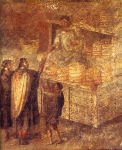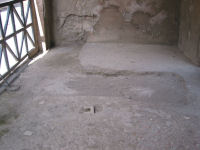
Figure 39: Wall painting of a bakery scene from the tablinum of VII.3.30, Pompeii. Museo Archeologico Nazionale di Napoli (MANN) inv. no. 9071.
The clearest outcome from this archaeological typology is the observation that the vast majority (81%) of properties with a masonry service counter also had a cooking facility and so can be considered to have retailed specifically food and drink. Scholars have mostly inferred, and sometimes questioned, this association, but never systematically tested it. Wallace-Hadrill, for example, suspects that various types of shop have been 'swept up' into the general lists of bars because of the presence of a counter (Wallace-Hadrill 1995, 46). It is of course likely that some counters, given the utilitarian nature of their form, operated in a mode of commerce other than the retail sale of food and drink. Indeed the Type B bars may testify to this, though their comparative scarcity indicates they are exceptional examples. Were it possible to count the number of wooden counters that once existed at Pompeii, then their number might send the total count of food and drink outlets upward. While the wooden structures themselves are no longer extant, their ancient existence occasionally leaves behind a slight 'scar' in the ground where a later floor surface was built against it, or in the wall if a subsequent plastering was smeared up to the counter. Even so, it is unlikely that wooden counters functioned in the same way as the masonry type: the constant use and exchange of liquids, and not least the danger of fire from cooking must have precluded their use in favour of the masonry type.

Figure 39: Wall painting of a bakery scene from the tablinum of VII.3.30, Pompeii. Museo Archeologico Nazionale di Napoli (MANN) inv. no. 9071.
That the preparation and sale of food and drink in Pompeii relied primarily on masonry counters is demonstrated not only by the fact that the vast majority of masonry counters are associated with evidence for cooking activities, but also by the lack of such fixtures in certain other types of establishments. Just two of the 19 bakeries at Pompeii sold bread from masonry counters (IX.1.3 and IX.3.10-12), doubtless because the production of bread was carried out in large ovens in back rooms, so its retail sale did not depend on cooking at or near a counter. That bakeries might have preferred wooden counters is suggested in a wall painting from the Casa del Panettiere (VII.3.30), in which a man distributes bread from behind a wooden counter (Figure 39; for discussion on this property: Fiorelli 1875, 208; Eschebach and Müller-Trollius 1993, 270-1). The scene is probably that of a bakery's shop-front: two men and a boy approach a wooden counter, stacked with loaves of bread, and a bread-seller behind the counter is handing a loaf to the man in the centre. Alternatively, this could be a scene of public munificence - even if at a bakery (see Fröhlich 1991, 236-41; Clarke 2003, 259-61). However this scene is read, it is clear that this bakery had a wooden counter. Another wall painting showing a wooden counter was found outside the entrance to IX.7.7 (Figure 40). This example portrays a woman selling shoes from behind a wooden counter to a customer seated on a couch to one side (Della Corte 1927, 9, fig. 3. See also Kampen 1981, no. III.42, fig. 46). Behind the counter are wooden cupboards storing other goods. Of the 128 Type A bars in Pompeii, only two appear to have operated with a wooden counter instead of a masonry one (I.6.8 - Figure 41 and IX.2.25). The remaining 98.5% are characterised by their masonry counters.


Figure 40: Wall painting of a shoe shop from Pompeii. Photograph courtesy of the Soprintendenza archeologica di Pompei.
Figure 41: Bar at I.6.8, Pompeii. Note the 'scarring' of an L-shaped counter in the ground from where a cement floor was poured against a wooden counter, since perished.
© Internet Archaeology/Author(s)
URL: http://intarch.ac.uk/journal/issue24/4/7.1.html
Last updated: Mon Jun 30 2008